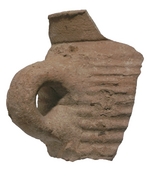Roman Amphorae: a digital resource
University of Southampton, 2005. (updated 2014) https://doi.org/10.5284/1028192. How to cite using this DOI
Data copyright © University of Southampton unless otherwise stated
This work is licensed under the ADS Terms of Use and Access.
Primary contact
Dr
David
Williams
Dept of Archaeology
University of Southampton
Avenue Campus
Highfield
Southampton
SO17 1BJ
England
Tel: 080 593032
Resource identifiers
- ADS Collection: 463
- DOI:https://doi.org/10.5284/1028192
- How to cite using this DOI
Carrot amphora

Courtesy of Dr. D. F. Williams
David Williams
Distinctive FeaturesA plain or rounded rim, which usually lacks a neck, small thick loop handles and a small tapered body, normally covered with horizontal rilling. However, there are a number of variations on this shape. Martin-Kilcher initially distinguished two variants (1994: Abb. 196, 1.2), while Vipard’s (1995) study shows that the typology of the carrot amphora is rather heterogeneous, including vessels of different sizes, rim diameters, tapered bodies and hollow spikes. Vipard ‘s (1995: 52-4) basic classification has three shapes: A - rounded body with conical outline; B - rounded body which narrows below the handles, having a sharper conical bottom; C - oblong short body and a variety of rims: 1 - turned down; 2 -vertical; 3 - everted.See characteristics | ||
Date RangeEarly first century AD at Wiesbaden and Vindonissa, common at Claudian Hofheim (Reusch, 1970) and Claudian-Neronian Colchester (Hawkes & Hull, 1947). They are found after AD 75 at Fishbourne (Cunliffe, 1971) and late first century AD to early second century from Barcelona (Carreras Monfort & Williams, 2002). If the three handle fragments of Type 85 at Oberaden are in fact from vessels of this type, the initial date for its appearance might be the last decade of the first century BC (Loeschcke, 1942).Search: [1st century BC] [1st century AD] [2nd century AD] | ||
OriginTomlin's (1992) argument for an Egyptian origin was based on an inscription from Carlisle which seems to mention dates from the Thebaid. However, the carrot amphora has not been found in Egypt and its fabric is quite unlike locally made amphorae (Tomber & Williams, 2000). Carrot amphorae are said to have been made in Beirut (Hayes, 1997; Reynolds, 2000a), though it is not entirely clear if these vessels are indeed of this form or something similar. Carreras Monfort & Williams (2002) suggest Palestine but the dearth of finds from this area is curious. It seems that the manufacturing centre directed most of its produce to the north-western parts of the empire.Search: [Palestine] [The Levant] | ||
DistributionIt is commonly associated with early military sites in Britain, Germany, and Pannonia (Reusch, 1970; Carreras Monfort & Williams, 2002), but other examples occur in Gaul, Spain and Italy (Carreras Monfort & Williams, 2002).Search: [Central Europe] [France] [Germany] [Great Britain] [Italy] [North West Europe] [Spain] [The Balkans] [Western Mediterranean] | ||
ContentsUnknown, but possibly dates (Reusch, 1970; Carreras Monfort & Williams, 2002). Small vessels of comparable, but not identical form, are shown in wall paintings at Herculaneum, and these could have been containers for dates as they are associated with fruit (Loeschcke, 1942: Fig. 29).Search: [Dates] | ||
CommentsPrincipal contributor: David Williams | ||
ClassificationAugst 44Camulodunum 189 Peacock & Williams 12 Pompeii 15 Schoene-Mau 15 | ||
CEIPAC linkThe following link will take you to the Centro para el Estudio de la Interdependencia Provincial en la Antiguedad Clásica CEIPAC database. In the CEIPAC system this amphora has the ID KE51+BYZ. Note: access to CEIPAC requires registration, which is possible via http://ceipac.ub.edu/corpus_reg.php?IDM=e | ||



 3D models
3D models


